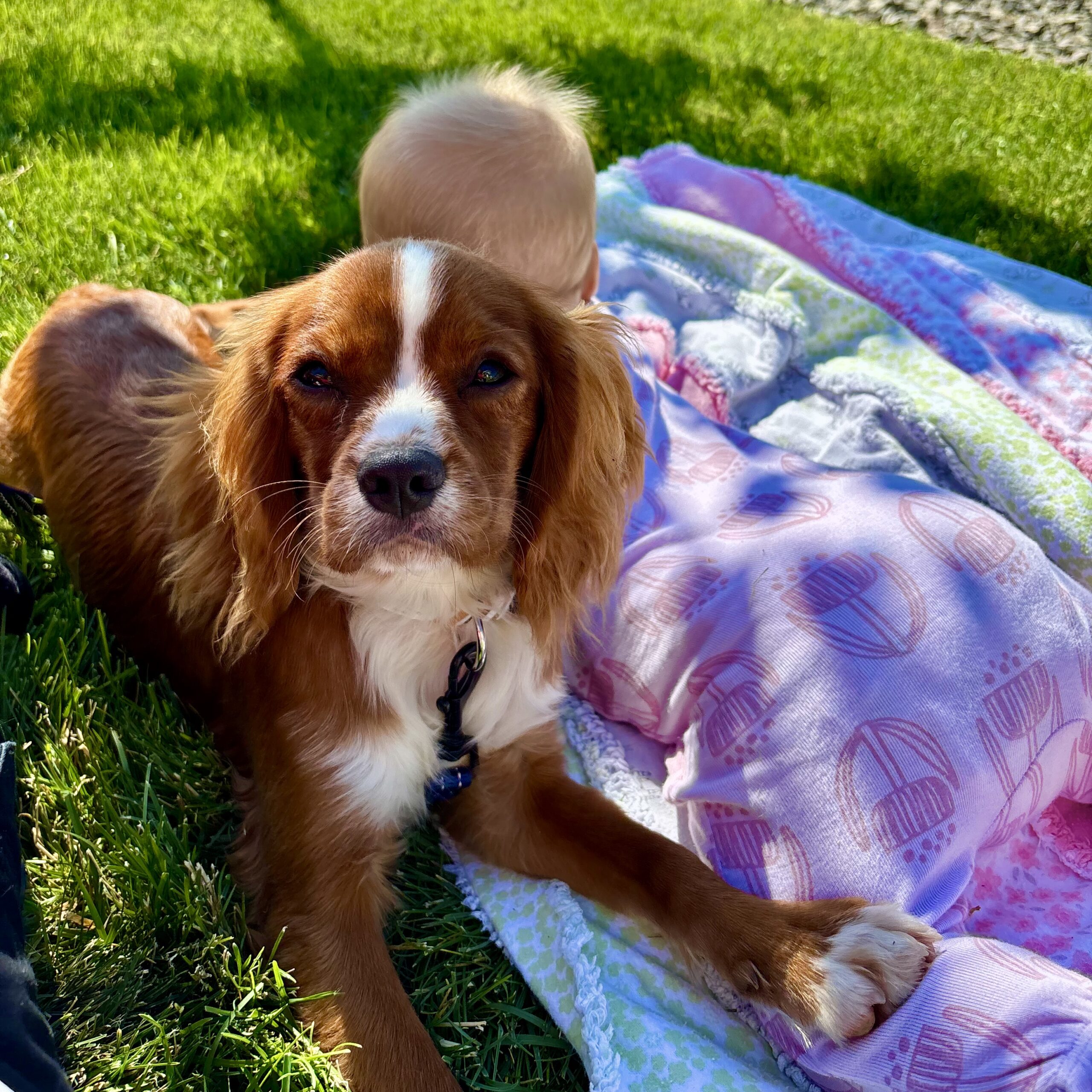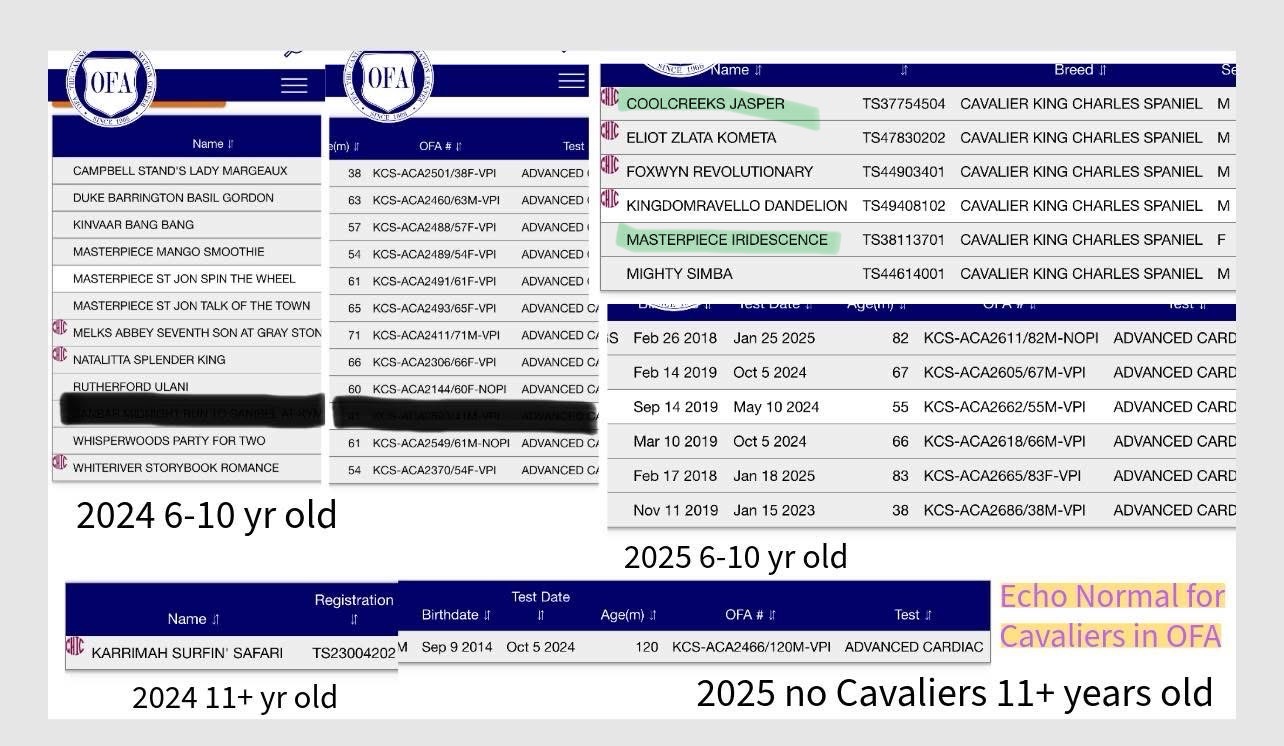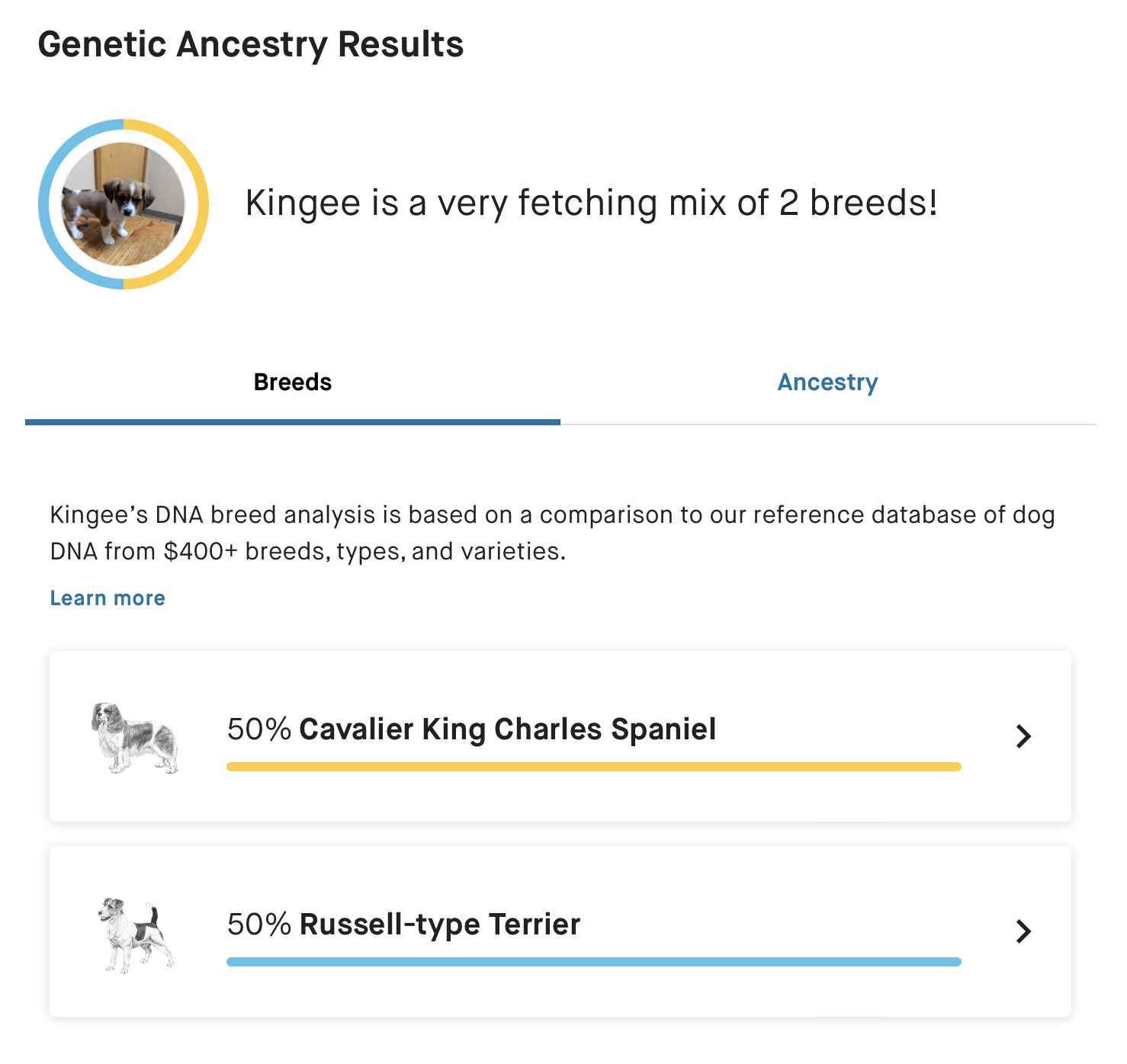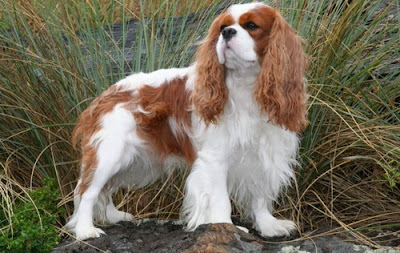MVD, Mitral Valve Disease in Cavaliers
MVD
Cavaliers often have early onset mitral valve disease and die young, making this the most prolific disease in the breed. Experts say about half the population of Cavaliers have MVD by 5 years of age and most have MVD by 10 years old.
On an auscultation, the heart of a Cavalier may sound good and “pass” up to 5 years of age. That same dog will often show beginning stage of MVD on an Echocardiogram on the same day, rating as a B1. After age 5 the rate of Cavaliers with increase of heart disease goes up significantly.
Most Cavaliers in the first few years of life show a B1 rating of the heart on an Echo. Ideally having a Cavalier stay at an A or B1 for life is best. The unknown age and rate of a Cavalier’s heart degeneration is the great fear of owners.
MVD affects many small breed dogs, usually late in life and infrequent per breed. For the purpose of the Cavalier outcross project, types of dogs blended in should either not have MVD or late onset MVD. Ideally, adding in plenty of medium to large size dogs into the population of the Cavalier cross-breeding project can assist in the reduction of MVD.
For a deep dive into MVD heart disease in Cavaliers check out the Cavalier Health page.

Breeding Strategy
Cavaliers should be paired with “other breeds” that do not have any MVD in their breed, or late onset MVD. Many small breed dogs have late onset MVD. Most medium and large breeds never have MVD.
We do not know what genes are involve, but science believes there are multiple genes contributing to MVD plus environmental factores. A new DNA test for the NEBL3 gene gives hope for Cavalier’s heart health. Much more data is needed showing corelation between late onset MVD, or no MVD, in senior age Cavaliers who have the NEBL3 gene.

OFA data on all Cavalier King Charles Spaniels for year 2024-2025 with a clear/ normal Echo, ages 6+ years old at time of exam. Less than 20 dogs are proven “heart healthy”.
Other 2024 Statistics of Cardiacs in OFA database of Cavaliers born in 2018 and prior, examined by a Cardiologist:
Abnormal: 18 dogs
Normal Cardiologist Auscultation: 108 dogs
(blacked out line is a duplicate of the same dog on the line above)
** Coolcreek’s Jasper is a stud dog for the Cavalier Improvement Project

THE TRUTH ABOUT THE “GOLDEN PROTECTIVE GENE” (ALSO KNOWN AS THE “UNICORN GENE”) IN CAVALIERS
Some breeders now advertise puppies as having the “golden protective gene”, also referred to as the “unicorn gene”, believed to reduce the risk of mitral valve disease (MMVD) in Cavalier King Charles Spaniels.
While this may sound encouraging, it is important to clearly understand what this gene may offer—and, more importantly, what it does not guarantee.
WHY THE “GOLDEN” OR “PROTECTIVE” OR “UNICORN” GENE DOES NOT GUARANTEE A HEALTHY HEART
1. Cavalier heart disease is influenced by many genes—not just one
Mitral valve disease (MMVD) is the most common heart condition in Cavaliers. According to veterinary genetic research, MMVD is not caused by a single gene. Instead, it is caused by multiple genetic factors combined with non‑genetic influences such as age and environment.
A dog may carry a beneficial gene variant, but other genes may still contribute to disease. Therefore, one “good” gene cannot be considered a protective shield.
2. Cavaliers carry substantial inherited risk
The Cavalier King Charles Spaniel breed has a history of heart issues passed down through generations due to ALL Cavaliers being MORE closely related than full siblings. Some gene variants may offer modest benefit, but they do not eliminate the other genetic risks inherent to the breed’s overall genetic makeup.
3. The “protective” gene is still under study
Early research suggested that Cavaliers with a specific variation of two “good” genes of the NEBL3 gene— might develop MMVD later in life or exhibit slower disease progression.
However, these findings are based on a small number of dogs and have not been validated in large-scale studies. The presence of the “protective” variant alone does not prevent heart disease and should not be perceived as a guaranteed form of protection.
We need more documenting of senior age Cavaliers with clear/normal Echo scans PLUS having two “good” copies of the NEBL3 gene. We need to see many hundreds of senior age Cavaliers “proof” to know if this gene is actually “protective”.

TESTING LABS
NEBL-Based MMVD Genetic Risk Tests for Cavalier King Charles Spaniels
The variant referred to as the “protective gene” corresponds to a specific single nucleotide polymorphism (SNP) in the NEBL3 gene.
Test: Myxomatous Mitral Valve Disease (MMVD)
1. GenSol Diagnostics (USA)
https://www.gensoldx.com/…/myxomatous-mitral-valve…/
2. LABOKLIN (Germany)
https://laboklin.com/…/myxomatous-mitral-valve-disease…/
3. LABOGEN (Germany)
https://labogen.com/…/myxomatous-mitral-valve-disease…/
4. CombiBreed (Germany)
https://www.combibreed.com/…/myxomatous-valvular…/
5. Dog Breeding Science (Australia)
https://breeding.dog/index.php?test=mvd
Data on Cavalier, MMVD & Inbreeding:
1. High Inbreeding Levels in Cavaliers
Cavaliers are more inbred than full siblings, with an average inbreeding coefficient of over 40%.
Institute of Canine Biology https://www.instituteofcaninebiology.org/…/cavaliers…
2. Cavaliers Carry a High Genetic Mutational Load
A study using whole genome sequencing shows Cavaliers have a higher number of potentially damaging variants, especially linked to heart disease.
PLOS Genetics https://journals.plos.org/plosgenetics/article?id=10.1371/journal.pgen.1009726
3. MMVD in Cavaliers is Multi-genes and Heritable
Genetic studies confirm MMVD is caused by multiple genes and cannot be prevented by targeting a single mutation.
ResearchGate – Genomic Study https://www.researchgate.net/…/344692921_A_Genomic…
Wiley Online Library – Aging Cell https://onlinelibrary.wiley.com/doi/abs/10.1111/age.13082
ResearchGate – Overview on MMVD https://www.researchgate.net/…/282879630_Mitral_Valve...
4. Epidemiological Risk in the Breed
MMVD is present in more than 50% of Cavaliers by age 5 and nearly 100% by age 10.
Universities Federation for Animal Welfare (UFAW) https://www.ufaw.org.uk/…/cavalier-king-charles-spaniel…
5. Rare Protective Variants Exist but Are Not Sufficient
Protective gene variants are rare in the population and cannot outweigh the overall risk in most Cavaliers.
Genetic Study Summary https://phys.org/pdf549794688.pdf
6. Genome-wide analysis of mitral valve disease in Cavalier King Charles Spaniels
Anne T French et al. (2012)
The Cavalier King Charles Spaniel (CKCS) often develops serious mitral valve disease at a young age. In this study, 36 purebred CKCS dogs were checked for heart murmurs and grouped into those with early or late onset of the disease. Researchers used a genome-wide genetic analysis to see if the condition was caused by a small number of genes. They found no clear genetic differences between the two groups and no specific gene regions linked to the disease. This suggests that mitral valve disease in CKCS is not caused by a single major gene, meaning that breeders currently cannot use genetic testing to prevent MVD.
Key Scientific Studies Supporting the NEBL‑Based MMVD Risk Test in Cavaliers
1. Mead et al. (2022)
Title: Genetic Variants at the Nebulette Locus Are Associated with Mitral Valve Disease Severity in Cavalier King Charles Spaniels
Full text (MDPI – Open Access): https://www.mdpi.com/2073-4425/13/12/2292
Summary: First study to identify NEBL1‑3 variants as associated with reduced MMVD severity in a subset of Cavaliers. Forms the scientific foundation for the genetic tests offered by labs like CombiBreed and LABOKLIN.
2. Donnelly et al. (2021)
Title: Deleterious Genetic Variants in Domestic Dogs: A Multi-Breed Comparative Analysis
Full text (PLOS Genetics – Open Access): https://journals.plos.org/plosgenetics/article?id=10.1371/journal.pgen.1009726
Summary: Cavaliers showed one of the highest mutational loads among breeds studied, including in genes associated with MMVD like NEBL. Confirms that the breed is genetically predisposed.
3. Axelsson et al. (2021)
Title: Accumulation of Deleterious Mutations Due to Extreme Inbreeding in CKCS
Full text (press summary PDF): https://phys.org/pdf549794688.pdf
Related News Summary: https://www.sciencedaily.com/rel…/2021/09/210902174655.htm
Summary: Highlights genetic bottlenecks and lack of diversity in CKCS. Explains why risk alleles like those in NEBL are now nearly fixed in the breed.
4. Lewis et al. (2011)
Title: Heritability of premature mitral valve disease in Cavalier King Charles spaniels
https://www.sciencedirect.com/…/abs/pii/S1090023310000778
Summary: An early landmark study showing MMVD appears in Cavaliers from a young age and is strongly inherited.
5. Stephenson et al. (2012)
Title: Prevalence of heart murmurs and MMVD in older Cavaliers
Full text (UFAW / Welfare report): https://www.ufaw.org.uk/…/cavalier-king-charles-spaniel…
Summary: Reports that 50% of Cavaliers have MMVD by age 5, and nearly all by age 10.
6. ResearchGate Study: Birkegård et al. (2020)
Title: A Genomic Study of Myxomatous Mitral Valve Disease in CKCS
Full text (ResearchGate): https://www.researchgate.net/…/344692921_A_Genomic…
Summary: Supports polygenic inheritance of MMVD. Notes that NEBL is one of several significant loci.
7. Wess et al. (2017)
Title: Echocardiographic Parameters and MMVD Progression in Small Breeds https://www.sciencedirect.com/…/abs/pii/S1090023310000778
Summary: Assesses MMVD progression metrics like LA:Ao and LVIDdN used in NEBL gene research.
Contact Us

